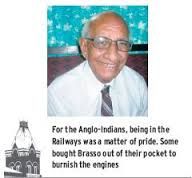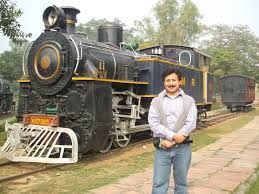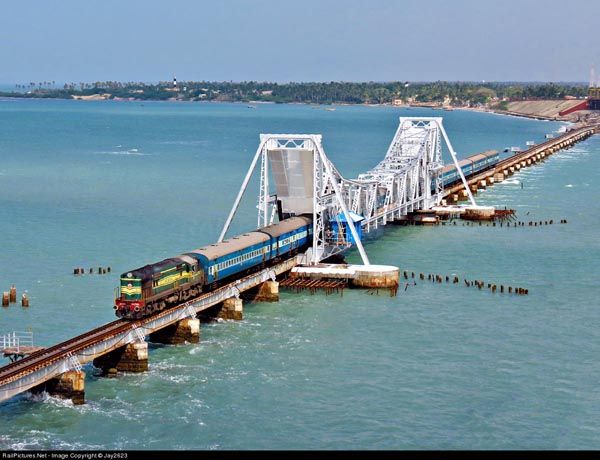Mark wrote:
Are there still any steam engines operating in India on any sort of scheduled basis?
> Wow! xl-target, your Indian Rail Journey is worth the envy

> I fondly remember visiting the Hubli (Karnataka/India) Loco Shed as an school boy - the look of the Steam Locomotives was an awe inspiring sight. Most of the locomotive drivers were Anglo-Indians then & the pride they took in driving & looking after them brought nothing but respect and admiration. The way they personally polished the brass name plates (some had even named them...'Betsy' - 'Laura'..... showed their love & attachment...

> Here's some heart rendering information I got from the net...
The last gasp for India's age of steam
Drivers mourn locomotives that united a nation
TIM MCGIRK IN JAIPUR Sunday 19 December 1993
MOHAN SINGH was lighting up the Desert Queen. It had taken nearly four hours. The rusty puffs from the locomotive would soon turn ash-white, and the Desert Queen would be ready to roll, ferrying rich tourists to Rajasthan palaces. He leaned out to admire the gleaming locomotive, its shining brass and copper piping, its painted lions and stars.
'It's pitiful,' said Mr. Singh, 56, as he pulled the long steel bow of the regulator, bringing up a whoosh of steam from the Desert Queen's giant wheels. 'Look at the other engines. Disgrace.' He gestured at the dozen steam locomotives in the Jaipur shed: sooty, exhausted carcasses of iron. 'Before, every engine was as beautiful as the Desert Queen. A driver and his engine were partners for 20 years, and his own money he would spend on dressing it up.'
Today, there is no point in prettying the locomotives. The age of steam engines is ending in India. Within six months, the last whistle will blow on the 175 steam locomotives still working the Western Railway, which, throughout the past century, has chugged across the Great Indian Desert and beyond. By 1996, all of India's remaining steam trains will be replaced by diesel ones, which cost less to maintain and are faster and more muscular.
Mr. Singh, like the old steam locomotives he drives, is due to retire soon. His arms and back still ache from all the years he worked as a fireman. To cover 120 miles through the scrub deserts and parched hills of Rajasthan, he and the other fireman had to shovel six tons of coal. In summer, the temperature might reach 50 degrees - and by the glowing mouth of the boiler it was hotter still. 'The young people don't want to do this job now,' he said with regret in his voice. 'They're too soft.'
When an engine driver retires, he is garlanded with flowers, lifted on to a horse and led home in a festive procession by his workmates. But no ceremony exists when a steam engine reaches the end of the line after 40 years on the tracks. A few can prolong their working life in the shunting yards or at the huge Ajmer railway workshop for steam engines. The locomotives are sold for scrap, at around pounds 4,000 each. But any enthusiast thinking of bringing one back to the United Kingdom would find it an ordeal: an Indian steam locomotive weighs around 80 tons.
My first encounter with one occurred a few years ago at a level crossing at 3am, on a road somewhere in the middle of India. Steam and sound exploded from everywhere; it was like a boiling tea kettle skidding across the kitchen floor. The locomotive's whistle had a mesmeric musicality which cast a spell of silence over cars, insects and people. In India, this is no small feat. The steam train's rhythm was different, too, as intricate as that of a TABLA DRUMMER. Unfortunately, that train speeding by at 3am was one I had hoped to catch.
Riding in a locomotive outside Ajmer, a lake city surrounded by craggy hills, I asked the driver, MAHI PAL, if he liked steam engines better than diesel ones. 'With steam locos you get the feeling of power in your hand,' he said, adding with a grin: 'You can also brew tea.'
For four generations, Mr. Pal's family has toiled on steam engines at the Ajmer railway colony, a huge city-within- a-city where giant sheds and foundries tower over schools, a hospital and a tidy row of garden huts. It has been a good life for the workers. The colony is insulated from the religious and caste suspicions sweeping India today. When the British set it up in the late 1870s, they hired Muslims, Hindus and Christians, giving the better jobs to the Anglo-Indians. There are many among Ajmer's 9,000 railway men whose links to steam trains stretch back as far as Mr. Pal's. They are all sorry to see the locomotives go.
In the ancient repair shed, where mammoth cranes thunder overhead in the blackness like prehistoric flying reptiles, a foreman, BHAG CHAND, explained: 'These are the engines that our grandfathers and fathers worked on. If they go, then the connection is finished.'
India's sense of identity, of nation, was forged largely by the steam engine. In a country as wide as the distance between London and Moscow and as long as that between Helsinki and Crete, with 870 million people speaking a dozen distinct languages and hundreds of dialects, the railway has united India far more than any conquering army. Since the first steam locomotive began the 20 mile run between Bombay and Thane on 16 April 1853, India has been woven together by hundreds of thousands of miles of track. Seen for the first time by farmers in their fields, the steam locomotive was often mistaken for a hissing, living creature.
Now, Indian Railways say they cater for nearly 4,000 million passenger journeys every year, and more than 100,000 potters earn their living just by making throw-away clay tea cups for passengers' chai.
Even today, many British train enthusiasts make pilgrimages to India to ride on the old steam engines. In colonial times, AJMER AND JAMALPUR workshops manufactured more than 500 broad and narrow gauge steam locomotives between 1895 and 1920. But in the post-war depression, engine- building was switched back to the UK to give jobs to Britons.
After independence in 1947, India began building its own steam engines at CHITTARANJAN. More than 3,000 locomotives were hammered together before the last one rolled out of the CHITTARANJAN shed in 1970. Its name, ANTHIM SITARA - 'Last Star' - paid homage to the Evening Star, the final British steam engine, built in 1960 at SWINDON.
Indian Railways seldom sacks its workers, so the steam engine workers in AJMER AND CHITTARANJAN will be given other jobs. Meanwhile, the debate between steam and diesel puffs ahead. Steam engines may be slower and more puny than diesel ones, but they are safer.
Out of every 100 accidents on Indian railways, only two involve steam trains. Diesel drivers are more likely to fall asleep or get drunk, while steam drivers are on their feet, adjusting gauges, torque gears and releasing pressure through the long, S-bend regulator.
But driver Mohan Singh thinks there is another reason: 'Maybe 20 men are sharing one diesel engine, changing always and useless to dress it up.
BUT WITH STEAM LOCOS, ONE MAN SPENDS MAYBE HIS LIFE WITH THE SAME ENGINE. HE CARES. HE FEELS LIKE HE OWNS IT!!!

Briha
















